Welcome to the enchanting world of black birds in Michigan, where the skies come alive with the diverse and captivating avian species that grace the state. From the intelligent and social crows to the melodious blackbirds, Michigan hosts a rich tapestry of winged wonders. Join us on a journey of exploration as we delve into the lives, behaviors, and habitats of these fascinating black birds, unraveling the mysteries that make them an integral part of Michigan’s natural heritage. Whether you’re a seasoned birder or a curious observer, prepare to be captivated by the allure of black birds in the picturesque landscapes of Michigan.
Here’s a list of 15 black birds in Michigan:
Red-winged Blackbird
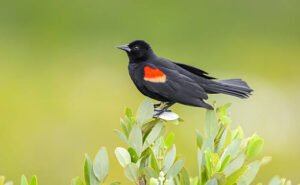
• Size: Males are robin-sized, and females are sparrow-sized.
• Weight: Males hefty, females petite.
• Lifespan: Average 2-3 years, some reach 15!
• Behavior: Males sing loud and puff red epaulets, females stealthy nest builders. Both join winter mega-flocks.
• Diet: Insect buffet, seed snatchers, and opportunistic omnivores.
A bold flash
The European Starling
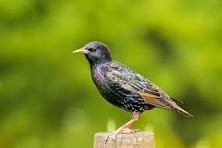
• Size: Robin-sized, about 20-23 cm (8-9 in) long with a 33-39 cm (13-15 in) wingspan.
• Weight: Light on their feet, weighing around 70-90 grams (2.5-3.2 oz).
• Lifespan: Can live up to 5 years in the wild, some reaching 10!
• Behavior: Highly social, forming bustling flocks that can blanket the sky. Mimic masters, capable of copying various bird calls and even car alarms! Ground feeders are often seen hopping and probing for insects and seeds.
These adaptable songbirds, native to Europe and Asia, have successfully colonized many corners of the globe, including North America. They’re quick learners and resourceful, making them both admired and sometimes unwelcome guests.
In a nutshell: A feathery whirlwind of chatter and acrobatics, the European Starling packs a lot of personality into its compact frame.
The Common Grackle
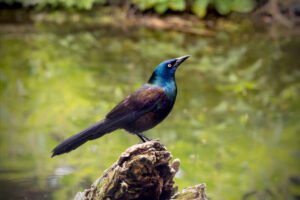
• Size and weight: Think crow in a shiny suit, about 11-13 inches long and a hefty 80-120 grams.
• Lifespan: These feathered friends can stick around for 3-5 years, with some reaching a sprightly 10!
• Behavior: Big mouths, big personalities! Grackles love to belt out loud calls, mimic other birds (and even car alarms!), and flock together in impressive, swirling clouds.
• Diet: These opportunistic eaters are all about variety, gobbling up insects, fruits, seeds, and even the occasional small critter.
In a nutshell: A bold, mischievous charmer with a booming voice and a twinkle in its eye, the Common Grackle adds a touch of feathered fun wherever it goes.
Cowbird
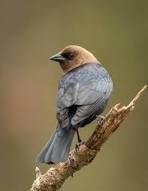
• Size: Think sparrow in disguise, petite at 6-7 inches and feather-light at 1.3-1.6 ounces.
• Lifespan: About 3 years, some masters of trickery can live up to 8!
• Behavior: A brood parasite extraordinaire! This sneaky bird lays its eggs in other birds’ nests, leaving the chicks to raise their young. Watch out, little robins!
• Diet: Seeds and insects, but loves free lunch (chick-snatching) whenever possible.
In a nutshell: Small in size, big in scheming, the Brown-headed Cowbird is a feathered Houdini of the nest, always ready to pull off a brood-jacking trick.
The Baltimore Oriole
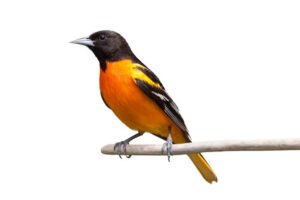
Size and weight: Think robin with a fiery fashion sense, about 7-8 inches long and weighing a breezy 1.2-1.6 ounces.
• Lifespan: These orange beauties can hang around for 3-8 years, some even reaching a fiery 12!
• Behavior: Skilled acrobats who love to hang upside down and flit through trees, showing off their vibrant orange and black plumage. Their sweet, whistled songs bring a touch of musical sunshine to any garden.
• Diet: Insectivores at heart, they love to snatch bugs and caterpillars, but they also enjoy nibbling on fruits and berries. Think of them as feathered garden helpers with a sweet tooth.
In a nutshell: A burst of sunshine on feathers, the Baltimore Oriole is a playful songbird with acrobatic skills and a taste for the finer things (like juicy bugs and berries). Their presence always adds a touch of vibrant joy to any corner of nature.
Eastern Meadowlark
Size and Weight: Think robin-sized with a bit more heft, around 9-11 inches long and weighing in at 1.5-2 ounces. Imagine a compact songbird with a sturdy build.
Lifespan: These cheerful birds can stick around for a good while, with an average lifespan of 3-5 years. Some exceptional meadowlarks have even been known to reach a sprightly 9 years!
Behavior: Eastern Meadowlarks are known for their beautiful, flute-like songs, often heard rising from meadows and grasslands. They love to perch on tall grass stems or fence posts, singing their hearts out to attract mates and defend their territory. These are ground-dwelling birds, spending most of their time foraging for insects and seeds among the grasses. You might even see them take flight with a fluttering, butterfly-like motion.
Diet: Primarily insectivores, they gobble up beetles, grasshoppers, and other crawlies. They also snack on seeds and berries, especially in the winter months when insects are scarce.
In a nutshell: A feathered songster with a love for wide-open spaces, the Eastern Meadowlark brings a melody of sunshine wherever it goes. Their beautiful songs, sturdy build, and fluttering flight make them a true delight to see and hear.
I hope this summary gives you a good glimpse into the fascinating world of the Eastern Meadowlark!
The Bobolink
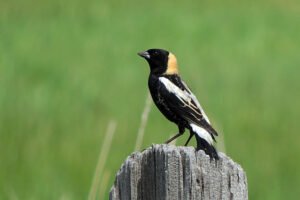
• Size and weight: Think robin-sized with a touch of elegance, measuring around 7-8 inches and weighing a light 1-1.5 ounces.
• Lifespan: These sky dancers can stick around for 3-7 years, with some record-breakers reaching a sprightly 10!
• Behavior: Bobolinks are masters of the air, taking off in explosive bursts of song and then gliding gracefully on long, pointed wings. Their bubbly song, a mix of whistles and warbles, is a true delight to hear, filling meadows and grasslands with joyful melodies. During breeding season, males puff out their black and white plumage in impressive displays to attract mates. But after raising their young, they undergo a dramatic transformation, molting into a streaky brown plumage that camouflages them perfectly during their long migration journey.
• Diet: Primarily insect-eaters, they feast on beetles, grasshoppers, and other crawlies. They also enjoy nibbling on seeds, especially during migration when insects are scarce.
In a nutshell: A feathered acrobat with a soundtrack of bubbly joy, the Bobolink brings a touch of magic to the skies. Their impressive flight displays, dramatic transformations, and sweet songs make them true avian superstars.
Rusty Blackbird
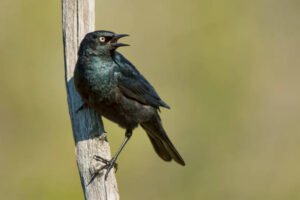
Size and Weight: Think robin-sized with a touch of elegance, measuring around 7-8 inches long and weighing a light 1-1.5 ounces. Imagine a sleek blackbird with a rusty sheen to its feathers.
Lifespan: These forest friends can stick around for 3-7 years, with some exceptional individuals reaching a ripe old age of 9!
Behavior: Rusty Blackbirds are shy and secretive, preferring the dense cover of coniferous forests. They flit through the branches with acrobatic grace, often heard before they’re seen. Their song is a beautiful, melancholic melody, filled with whistles and warbles that echo through the woods. During the breeding season, males puff out their chests and display their rusty wings to attract mates. But unlike many other blackbirds, they’re solitary nesters, building their hidden nests deep within the forest.
Diet: Primarily insect-eaters, they feast on beetles, caterpillars, and other tasty bugs found in the forest canopy. They also enjoy berries and seeds, especially during the winter months when insects are scarce.
In a nutshell: A shy songbird with a touch of mystery, the Rusty Blackbird brings a melody of the north to the forests it calls home. Their beautiful calls, acrobatic flight, and secretive nature make them a treasure to encounter in the wild.
The Orchard Oriole
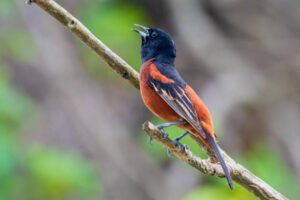
• Size and Weight: Think robin-sized with a touch of flair, measuring around 7-8 inches and weighing a breezy 1-1.5 ounces. Picture a compact songbird with a splash of sunshine on its feathers.
• Lifespan: These cheery companions can stick around for 3-7 years, with some even reaching a juicy 9!
• Behavior: Orchard Orioles are acrobatic performers, flitting through orchards and hedgerows with bursts of orange flashes. Their sweet, bubbly song, filled with whistles and trills, is a soundtrack to summer days. They love to hang upside down from branches, weaving intricate nests suspended like hidden hammocks. But unlike other orioles, these sun-kissed birds are shy and secretive, rarely venturing far from their leafy havens.
• Diet: Primarily insectivores, they gobble up beetles, caterpillars, and other tasty bugs found among the leaves. But their real passion lies in ripe fruits, especially cherries, berries, and even grapes. They’re expert fruit thieves, using their sharp beaks to snatch the juiciest treats.
In a nutshell: A feathered charmer with a sweet tooth for sunshine and berries, the Orchard Oriole adds a melody of summer joy to any garden or orchard. Their acrobatic antics, beautiful songs, and shy nature make them a delight to see and hear.
Brewer’s Blackbird
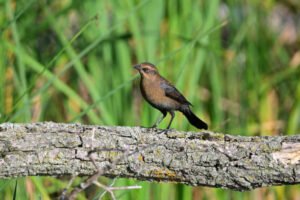
• Size and weight: Think robin in a sleek suit, around 9-11 inches long and a hefty 1.5-2 ounces. Imagine a sturdy blackbird with a bit more mountain muscle.
• Lifespan: These high-altitude heroes can stick around for 3-5 years, with some reaching a peak of 8!
• Behavior: Brewer’s Blackbirds are social singers, gathering in bustling flocks that fill the mountain air with their rich, flute-like melodies. They love perching on rocks and rooftops, puffing out their chests, and flashing their iridescent feathers to attract mates and defend territories. These acrobatic flyers dip and dive through air currents with impressive agility, often seen near meadows and forests seeking tasty morsels.
• Diet: Primarily insect-eaters, they feast on beetles, grasshoppers, and other critters found among the mountain flora. But they’re also opportunistic diners, enjoying seeds, berries, and even the occasional small fruit when available.
In a nutshell: A feathered musician with a taste for adventure, the Brewer’s Blackbird brings a symphony of sound to the high peaks. Their beautiful songs, playful acrobatics, and social spirit make them a true delight of the mountain air.
The Yellow-headed Blackbird
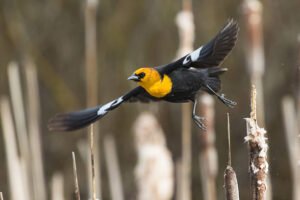
Size and weight: Think robin-sized with a dash of dapper, measuring around 8-10 inches and weighing just 1.5-3.5 ounces. Imagine a compact blackbird with a crown of sunshine.
• Lifespan: These bright sparks can stick around for 2-3 years, with some exceptional individuals reaching a golden age of 8!
• Behavior: The Yellow-headed Blackbird is a show-off! Males strut their stuff, puffing out their bright yellow heads and shoulders while belting out loud, clear songs to attract mates. They’re social creatures, forming bustling flocks that dance across fields and marshes, a flash of black and gold against the sky. But unlike most blackbirds, they’re ground nesters, building hidden homes among tall grasses.
• Diet: Omnivores with a taste for adventure, gobble up insects, seeds, and even small snails. They’re opportunistic feeders, always on the lookout for the next tasty morsel, whether in fields, marshes, or even backyards.
In a nutshell: A feathered charmer with a splash of sunshine, the Yellow-headed Blackbird brings a flash of personality wherever it goes. Their bold displays, bright plumage, and curious appetite make them a captivating sight and a reminder that even the smallest birds can have the biggest personalities.
Western Meadowlark
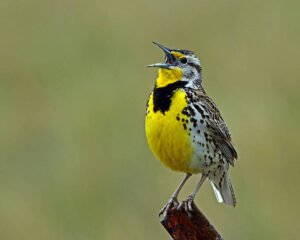
Size and weight: Think robin with a western twang, about 9-11 inches long and a comfortable 1.5-2 ounces. Imagine a sturdy songbird with a touch of prairie charm.
• Lifespan: These grassland troubadours can serenade for 3-5 years, with some reaching a sprightly 8!
• Behavior: Western Meadowlarks are masters of melody, filling the air with their rich, flute-like songs that rise from meadows and grasslands. They love perching on fence posts or tall grass stems, puffing out their yellow chests and flashing their black bibs while belting out their beautiful tunes. These agile flyers glide with graceful dips and dives, often seen foraging for insects among the grasses.
• Diet: Primarily insect-eaters, they feast on beetles, grasshoppers, and other crawling critters. But they also enjoy a varied menu of seeds, berries, and even the occasional small fruit, especially during winter months.
In a nutshell: A feathered musician with a passion for wide-open spaces, the Western Meadowlark brings a symphony of sound to the prairies. Their beautiful songs, graceful flight, and adaptable diet make them a true delight in the grassland landscape.
The Hooded Oriole
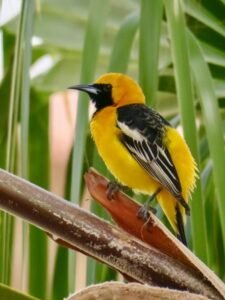
• Size and weight: Think robin with a touch of mystery, around 7-8 inches long and weighing a breezy 1-1.5 ounces. Imagine a compact songbird with a hidden identity under its hood.
• Lifespan: These masked marvels can stick around for 3-5 years, with some exceptional individuals even reaching a ripe old age of 8!
• Behavior: Hooded Orioles are shy songsters, preferring the leafy havens of swamps and forests. They flit through the branches with acrobatic grace, their golden bodies flashing amongst the green. Unlike their flamboyant oriole cousins, they keep their faces hidden beneath a black mask, adding to their air of intrigue. Their song is a beautiful, melancholic melody, filled with whistles and warbles that echo through the woods. They build intricate, hanging nests, often suspended like hidden lanterns from tall branches.
• Diet: Primarily insect-eaters, they feast on beetles, caterpillars, and other tasty bugs found among the leaves. But their true passion lies in ripe fruits, especially berries, and even the occasional juicy fig. They’re expert fruit thieves, using their sharp beaks to snatch the sweetest treats.
In a nutshell: A feathered enigma with a penchant for fruit and melody, the Hooded Oriole adds a touch of mystery to the tropical forests they call home. Their beautiful songs, acrobatic antics, and masked faces make them a captivating sight and a reminder that even the shyest creatures have a song to sing.
Shiny Cowbird
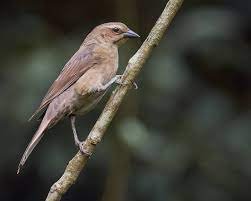
Size and Weight: Think robin-sized with a dash of glitz, measuring around 7-8 inches and weighing a light 1-1.5 ounces. Imagine a compact blackbird adorned with shimmering purple and bronze feathers.
Lifespan: These feathered jewels can stick around for 3-5 years, with some even reaching a shiny age of 8!
Behavior:
• Acrobatic Flyer: Watch them flit through trees and fields with quick bursts and graceful dips, often hovering near cattle to snatch insects disturbed by their grazing.
• Melodious Mimic: They may not have their own song, but they’re talented mimics, incorporating the calls of other birds into their own vocalizations, creating a unique feathered chorus.
• Global Traveler: Shiny Cowbirds are migratory marvels, journeying long distances between their breeding and wintering grounds, adapting to diverse habitats like grasslands, forests, and even parks.
In a nutshell: The Shiny Cowbird is a captivating mix of iridescent beauty, agile flight, and vocal mimicry, adding a touch of feathered wonder to the skies it travels.
The Bullock’s Oriole
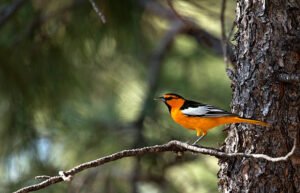
Size and Weight:
• Length: 7-8 inches
• Wingspan: 12 inches
• Weight: 1.5 ounces
• Lifespan:
• The average lifespan of a Bullock’s Oriole is around 5-7 years in the wild. However, some individuals have been known to live for up to 12 years.
Behavior:
Bullock’s Orioles are active and social birds. They are often seen foraging for food in trees and shrubs, and they are known for their loud and melodious songs. These orioles are monogamous and mate for life. They typically build their nests in trees or shrubs, and the female lays 3-5 eggs. Both parents care for the young until they fledge.
Interesting Facts:
• Bullock’s Orioles are named after William Bullock, an English naturalist who collected the first specimen of the bird in Mexico in 1825.
• These birds are migratory and spend the winter in southern Mexico and Central America.
• Bullock’s
In conclusion
the black birds in Michigan paint a captivating tapestry across the state’s skies. From the intelligent and social crows to the melodious blackbirds, their diverse species showcase the rich avian biodiversity. Understanding their behaviors and habitats not only enhances our appreciation for these winged wonders but also underscores the importance of preserving Michigan’s ecosystems for generations to come. As guardians of the natural balance, these black birds contribute to the state’s unique ecological story, making their presence both fascinating and integral to Michigan’s natural heritage.
Read our recent post on Medium


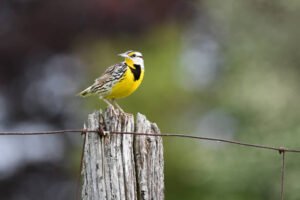



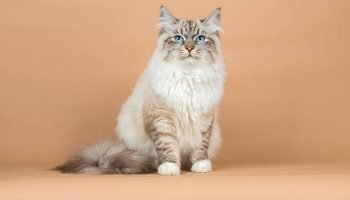








1 Comment